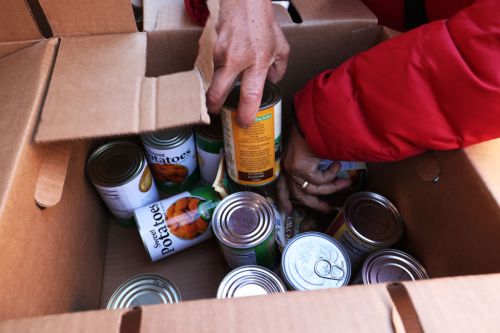Massive ripple effects are being felt across the U.S. as a result of the economic fallout from the pandemic—particularly when it comes to people’s ability to afford basic needs like food. Feeding America, a national nonprofit aiming to combat hunger, projects that 42 million people, including 13 million adults, will experience food insecurity in 2021. And the Supplemental Nutrition Assistance Program (SNAP), a federal-aid initiative that supplied food to 38 million people in 2019, saw enrollment increase to nearly 42 million individuals last year.
Experts in This Article
Erin Brantley is a senior research associate at the George Washington University Milken Institute School of Public Health.
Right now, the normal prerequisites for qualifying for SNAP benefits are temporarily suspended under the Families First Coronavirus Response Act (FFCRA)–which went into effect last March and is set to continue through the duration of the pandemic. But eventually, when FFCRA ends, Black, able-bodied adults without dependents and people with disabilities are at the greatest risk to lose their food assistance due to the SNAP work requirements necessary to maintain eligibility. That’s according to recent research conducted by George Washington University.
Under current law, adults able to work must do so for at least 20 hours per week or 80 hours per month in order to qualify for SNAP.This rule was initially introduced in the ’90s as part of the Personal Responsibility and Work Opportunity Reconciliation Act (PRWORA). It was intended to encourage self-dependency over reliance on government assistance, but in practice, it’s become a barrier to receiving benefits that many in vulnerable populations are unable to overcome.
From 2013 to 2017, SNAP work requirements led to more Black adults losing food assistance compared to white adults, says Erin Brantley, PhD, MPH, senior research associate at the Milken Institute School of Public Health, who lead the study for GWU. Black households already report food insufficiency at three times the rate of white households prior to the pandemic. Now they have the highest rates of food hardships compared to any other demographic.
Why SNAP work requirements negatively impact Black adults disproportionately
Dr. Brantley says the primary reason for this is because the program doesn’t account for the discrimination people experience based on race when it comes to finding jobs. “Experiments show that employers are less likely to hire people who present as Black in the application process,” she explains.
Not only are Black adults more likely to experience inequities in the job-hiring process, but they are also more likely to be unemployed during the pandemic. From February to April 2020, Black workers faced the highest unemployment rates, according to the Economic Policy Institute. Black men experienced the highest unemployment rate of any demographic, followed by Black women, in the fourth quarter of last year, reports the U.S. Bureau of Labor Statistics.
Compounding this problem is the fact that, even if a person is unemployed but actively looking for work, searching for a job doesn’t count toward SNAP work requirements, says Dr. Brantley. “People could be trying as hard as they could [to find work], but there’s no allowance for that in this particular policy,” she explains.
These self-reliant safeguards pose similar problems for people with disabilities attempting to enroll in SNAP
SNAP’s general work requirements only apply to people who are able to work. But people with disabilities must first prove they qualify for an exemption in order to have this stipulation waived. “Caseworkers have discretion in determining if the person in front of them is [unable] to work,” says Dr. Brantley. That’s if they don’t automatically receive an exempt status by meeting one of the following six criteria from the USDA:
- You receive federal disability or blindness payments under the Social Security Act, including Supplemental Security Income (SSI) or Social Security disability or blindness payments.
- You receive state disability or blindness payments based on SSI rules.
- You receive a disability retirement benefit from a governmental agency because of a permanent disability.
- You receive an annuity under the Railroad Retirement Act and are eligible for Medicare or are considered disabled under SSI.
- You are a veteran who is totally disabled, permanently homebound, or in need of regular aid and attendance.
- You are the surviving spouse or child of a veteran who is receiving VA benefits and is considered permanently disabled.
From 2013 to 2017, the SNAP program saw a 7.8 percent decline in participation among people with disabilities when work requirements resumed despite unemployed adults with disabilities being two times more likely to experience food insecurity compared to able-bodied adults.
Unpausing SNAP work requirements when the pandemic’s over could put both these groups at greater risk
“When the public health emergency ends, these SNAP work requirements for childless adults will come back pretty immediately which is problematic—it would make more sense to tie them to an economic indicator of employment because that’s the more relevant factor here,” says Dr Brantley. And that’s possible because states can ask the USDA for waivers to suspend SNAP work requirements due to insufficient jobs. (As of February, the national unemployment rate was still 2.7 percent higher compared to the same month last year.)
Currently, Dr. Brantley says that there are no policies or efforts in place to rescind work requirements permanently from the SNAP program. But she’d like to see the policy amended based on the research and data that shows its disproportionate impact on at-risk populations. “They cause harm that I and many people would consider unfair,” she says. “People who have the most trouble finding work are the poorest people, people with disabilities, and people who face racial discrimination when they go to apply for jobs.”
Sign Up for Our Daily Newsletter
Get all the latest in wellness, trends, food, fitness, beauty, and more delivered right to your inbox.
Got it, you've been added to our email list.











